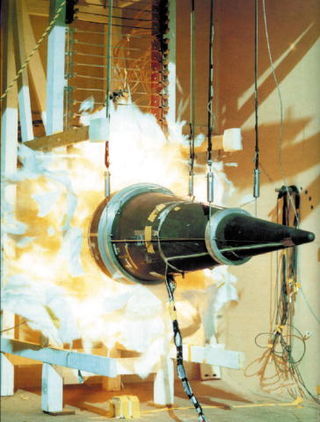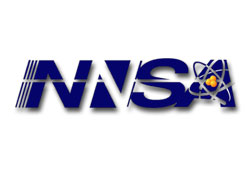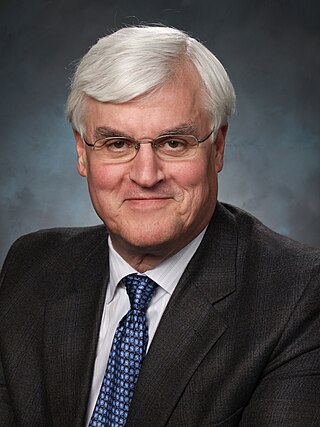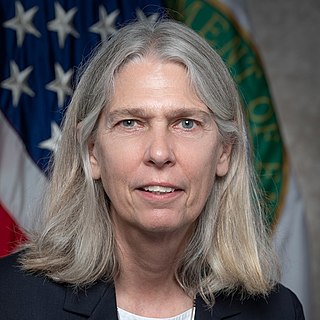
Los Alamos National Laboratory is one of the sixteen research and development laboratories of the United States Department of Energy (DOE), located a short distance northwest of Santa Fe, New Mexico, in the American southwest. Best known for its central role in helping develop the first atomic bomb, LANL is one of the world's largest and most advanced scientific institutions.
Lawrence Livermore National Laboratory (LLNL) is a federally funded research and development center in Livermore, California, United States. Originally established in 1952, the laboratory now is sponsored by the United States Department of Energy and administered privately by Lawrence Livermore National Security, LLC.

The United States Department of Energy (DOE) is an executive department of the U.S. federal government that oversees U.S. national energy policy and energy production, as well as manages the research and development of nuclear power, the military's nuclear weapons program, nuclear reactor production for the United States Navy, energy-related research, and energy conservation.

ASCI White was a supercomputer at the Lawrence Livermore National Laboratory in California, which was briefly the fastest supercomputer in the world.

High-performance computing (HPC) uses supercomputers and computer clusters to solve advanced computation problems.

Stockpile stewardship refers to the United States program of reliability testing and maintenance of its nuclear weapons without the use of nuclear testing.

ASCI Blue Mountain is a supercomputer installed at the Los Alamos National Laboratory in Los Alamos, New Mexico. It was designed to run simulations for the United States National Nuclear Security Administration's Advanced Simulation and Computing program. The computer was a collaboration between Silicon Graphics Corporation and Los Alamos National Laboratory. It was installed in 1998.

The Advanced Simulation and Computing Program is a super-computing program run by the National Nuclear Security Administration, in order to simulate, test, and maintain the United States nuclear stockpile. The program was created in 1995 in order to support the Stockpile Stewardship Program. The goal of the initiative is to extend the lifetime of the current aging stockpile.

The United States was the first country to manufacture nuclear weapons and is the only country to have used them in combat, with the bombings of Hiroshima and Nagasaki in World War II. Before and during the Cold War, it conducted 1,054 nuclear tests, and tested many long-range nuclear weapons delivery systems.

Michael Anastasio led two national science laboratories during a time of transition. He was the director of the Los Alamos National Laboratory and president of the Los Alamos National Security LLC, the company that operates the laboratory. He is the former director of Lawrence Livermore National Laboratory (LLNL). The University of California Board of Regents appointed Michael R. Anastasio the director of LLNL on June 4, 2002. He started on July 1, 2002. In 2005 he became the president of the Los Alamos National Security LLC, and became the director of the Los Alamos National Laboratory on June 1, 2006. During his directorship at Lawrence Livermore, the laboratory won 25 R&D 100 Awards and maintained its world-class leadership position in high-performance computing and its application to global climate modeling.

Curtis Bruce Tarter is an American theoretical physicist. He was the director of the Lawrence Livermore National Laboratory from 1994-2002. As director emeritus he recently published the first comprehensive history of the laboratory.
Ray E. Kidder was an American physicist and nuclear weapons designer. He is best known for his outspoken views on nuclear weapons policy issues, including nuclear testing, stockpile management, and arms control.

John C. Browne is an American physicist.
The National Nuclear Security Administration (NNSA) is a United States federal agency responsible for safeguarding national security through the military application of nuclear science. NNSA maintains and enhances the safety, security, and effectiveness of the U.S. nuclear weapons stockpile; works to reduce the global danger from weapons of mass destruction; provides the United States Navy with safe and effective nuclear propulsion; and responds to nuclear and radiological emergencies in the United States and abroad.

The Los Alamos Neutron Science Center (LANSCE), formerly known as the Los Alamos Meson Physics Facility (LAMPF), is one of the world's most powerful linear accelerators. It is located in Los Alamos National Laboratory in New Mexico in Technical Area 53. It was the most powerful linear accelerator in the world when it was opened in June 1972. The technology used in the accelerator was developed under the direction of nuclear physicist Louis Rosen. The facility is capable of accelerating protons up to 800 MeV. Multiple beamlines allow for a variety of experiments to be run at once, and the facility is used for many types of research in materials testing and neutron science. It is also used for medical radioisotope production.

The Office of Nuclear Energy (NE) is an agency of the United States Department of Energy which promotes nuclear power as a resource capable of meeting the energy, environmental, and national security needs of the United States by resolving technical and regulatory barriers through research, development, and demonstration.

Penrose "Parney" C. Albright is an American physicist known for his work with the U.S. Government, think tanks and National Laboratories, and government contractors. Since November 1, 2014, he has been the president and CEO of HRL Laboratories, a research firm jointly owned by Boeing and General Motors. Until December 2013 he served as the director of Lawrence Livermore National Laboratory, and, in 2014, he served as a senior advisor in the Office of the Director of National Intelligence.

Harold Palmer Smith Jr. is an American professor, consultant, and expert on defense policy. He was Assistant to the Secretary of Defense from June 1993 to March 1996, when the name of the position changed to Assistant Secretary of Defense for Nuclear, Chemical & Biological Defense Programs, and remained in the position until January 1998.

Jill M. Hruby is an American mechanical engineer and government official. Since July 26, 2021, Hruby has served as Under Secretary of Energy for Nuclear Security and Administrator of the National Nuclear Security Administration, a post subject to Senate confirmation. Jill Hruby made history as the first woman to ever head a U.S. nuclear weapons lab, serving as director of Sandia National Laboratories from 2015-2017.

Marvin L. Adams is a nuclear engineer and computational physicist. Since April 2022, he has served as Deputy Administrator for Defense Programs at the National Nuclear Security Administration (NNSA) in the Biden administration.

















